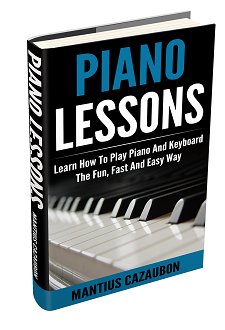Digital Pianos - How To Choose
There are all kinds of digital pianos on the market today. Many of them leave much to be desired. If you've played keyboards for a while, I'm sure you've come across a few of them which sounded like crap. For instance a piano voice which sounds more like a guitar being plucked. You know how disappointing this can be. This is characteristic of cheaper models. As with most musical instruments, price is usually a good indicator of value. So don't expect to get a top-of-the-line digital piano, with the touch, feel and sound of an acoustic piano for a few hundred bucks. Be prepared to spend good money for a quality model.
Highly Recommended: Go here for the BEST piano/keyboard course I’ve seen on the Internet.
Prices vary greatly. Those like the Nord Stage 88 Stage Piano can cost as much as $3,300.00 while models like the Yamaha NP30 Portable go for as little as $300.00. This makes a tremendous statement about quality, particularly when it comes to the weighted action. Some models may be labelled as digital pianos but when you investigate further you will realize that this is not really the case because of the absence of important features like Graded Hammer Effect and AWM (Advanced Wave Memory) Dynamic Stereo Sampling.
When shopping for digital pianos, pay close attention to the instrument's capabilities as far as Graded Hammer Effect is concerned. On an acoustic piano, keys are heavier in the lower registers of the keyboard and lighter in the higher registers. This is because the hammers get smaller as you move up the piano. Your instrument should be able to produce this same effect. Otherwise you won't get that piano experience. Semi-weighted and light-weighted keyboards will never give you the touch and feel you need. When buying your instrument be sure to read user reviews to see whether the manufacturer description paints a true picture. As far as digital pianos are concerned, weighted keys and Graded Hammer Effect are a must. But some keyboards are better at reproducing this effect than others.
Not only is the touch and feel important, but of arguably equal importance is the actual piano sound on your instrument. No matter how much of a player you are you can't fool people for too long with a cheesy piano tone. Personally, I have been amazed by the many "piano tones" I've heard that sounded nothing like a piano. If you're like me you have been unpleasantly surprised. You should try to find out how well the tones on your digital piano were sampled. Only the most advanced sampling technology will do. For instance, the best Yamaha models are famous for their AWM (Advanced Wave Memory) Dynamic Stereo Sampling. Digital technology is used to record an acoustic instrument, and high-quality digital filter technology is applied to the recorded samples. Also, samples are recorded at various levels of playing strengths. This results in a sound that closely resembles the real thing.
So why should you buy a digital piano instead of an acoustic? There are several reasons for this.
So what are the drawbacks?
Sound quality
No matter how well digital pianos are sampled, nothing beats the real thing. It's still a digital sound. Even the best digital models do not match the sound of real acoustic instruments. I admit that the gap between the acoustic and digital sound is slowly closing, thanks to improvements in technology. But digital sound will never equal or surpass acoustic sound.
Loss of "color".
The "colors" that can be produced on an acoustic instrument is almost infinite. You can use various playing techniques to "color" your tone. Not so on a digital model. Since the sounds are already recorded, there's very little one can do to vary the sound produced. An experienced pianist will recognize the difference.
Touch and Feel
Nothing can really match the touch and feel of an acoustic piano. Digital pianos merely simulate the action of acoustic counterparts. Weighted Action and Touch Sensitivity is very different to the sophisticated inner mechanism of acoustic pianos.
Longevity
An acoustic piano holds its value for years upon years. It can last over 100 years, and your children and grandchildren would be able to use it. The same cannot be said of a digital which may be obsolete in the next 5 years, due to the dynamic nature of technology.
I guess, at the end of the day, price has a big part to play. Most players are not prepared to dish out all their earnings to buy an acoustic. Digital is their only option. To add to that, most listeners won't be able to tell the difference between a top-of-the line digital sound and an acoustic.
Well-known manufacturers include Yamaha, Roland, Kurzweil, Korg Casio, and Kawai. If you're looking to buy one, some of my suggestions are Roland RD700SX, Yamaha YDP223, Yamaha P70, Casio PX110 Privia, Yamaha YDP213, and Casio AP80R. Yamaha Clavinovas are another option to consider. Since the focus of this site is on the Yamaha brand, (Yamaha-Keyboard-Guide.com) we have several reviews of Yamaha digital pianos here. At the end of the day, I can't tell you what to buy because it's all about your personal tastes, skill, and budget. I have published a guide to choosing the best keyboard for you here.
Search This Site:

Recommended For You
Learn to play piano and keyboards:
Click here to learn how to play keyboards and piano (with Piano For All).
Go here to buy a Yamaha keyboard.
Check out How To Read Music Fast: A 4-Step Beginner's Guide To Reading Music Quickly And Easily.





New! Comments
Have your say about what you just read! Leave me a comment in the box below.